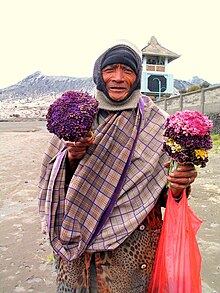Anaphalis javanica, the Javanese edelweiss, is a species of flowering plant native to Indonesia. It is found mostly in mountainous regions of Java, southern Sumatra, southern Sulawesi and Lombok.[3] Although a mature plant can reach eight metres in height, most specimens are less than a metre tall.[4] It is a pioneer in recent volcanic land.[5] The flowers are generally seen between April and August.[3] A bird species, the Javan whistling thrush (Myophonus glaucinus), nests in the plant's branches.
| Anaphalis javanica | |
|---|---|

| |
| A person selling Anaphalis javanica (Javanese edelweiss) on Mount Bromo. | |
| Scientific classification | |
| Kingdom: | Plantae |
| Clade: | Tracheophytes |
| Clade: | Angiosperms |
| Clade: | Eudicots |
| Clade: | Asterids |
| Order: | Asterales |
| Family: | Asteraceae |
| Genus: | Anaphalis |
| Species: | A. javanica
|
| Binomial name | |
| Anaphalis javanica (Reinw. ex Blume) DC.[1]
| |
| Synonyms[2] | |
|
Gnaphalium javanicum Reinw. ex Blume | |
Threats
editKnown as bunga abadi in Indonesian (lit. 'eternal flower'), senduro[5] (ꦱꦼꦤ꧀ꦝꦸꦫ sêndhurå) in Javanese or tanalayu (ꦠꦤꦭꦪꦸ, 'never wilts') among the Tenggerese,[6] this plant is popular among tourists. Dried flowers are often sold as souvenirs. This could lead to the destruction of the wild-grown species. In the Bromo-Tengger region in East Java, this plant is considered extinct. This species is constantly decreasing in number and is currently protected in Gunung Gede Pangrango National Park.[7]
The plant has been protected under Indonesian law since 1990.[4]
Gallery
edit-
Javanese edelweiss field on Mount Papandayan
-
Javanese edelweiss
-
A close-up of a Javanese edelweiss flower
References
edit- ^ Candolle, Augustin Pyramus de. 1837. Prodromus Systematis Naturalis Regni Vegetabilis 6: 271
- ^ The International Plant Names Index
- ^ a b Whitten, Tony and Jane (1992). Wild Indonesia: The Wildlife and Scenery of the Indonesian Archipelago. United Kingdom: New Holland. p. 127. ISBN 1-85368-128-8.
- ^ a b Diamond, Deviana (April 14, 2020). "14 Facts of Anaphalis javanica, the Edelweiss Flower Symbol of Eternal Love". IDN Times. Archived from the original on April 27, 2021. Retrieved April 27, 2021.
- ^ a b Mangku Purnomo (2011). Governing Resources in a Changing Environment: Local Responses in Contemporary Rural East Java, Indonesia. Göttingen University. p. 37. ISBN 3863950305.
- ^ Nedi Putra (Nov 8, 2018) "Edelwiss tourist villages to open in Bromo National Park". The Jakarta Post.
- ^ Andryanto, S. Dian (2021-06-18). "Pemetik Bunga Edelweis Bisa Diganjar Sanksi Pidana Bui 10 Tahun, Ini Pasalnya". Tempo. Retrieved 2022-07-12.